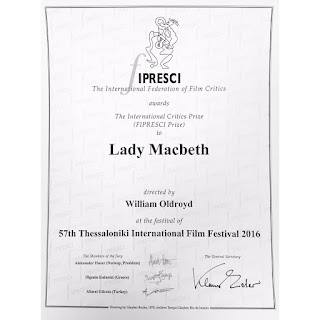The Groom always rings twice
Of unhappy and restless women the nineteenth century litterature is full.
Just think of Tolstoy's Anna Karenina and Emma Bovary by Flaubert,
romantic heroines who are ready to sacrifice everything for the wrong love,
for their lust for life.
In other words, there was nothing particular to expect from this film,
except to watch it "out of a sense of duty",
at the 57th International Film Festival in Salonika!
But when I left the cinema,
it was something magisterial that I had just seen!
Since then, I have learned that William Oldroyd,
and screenwriter Alice Birch,
"both made a name for themselves at the theater in London before arriving at the cinema".
William Oldroyd has worked as a director at the Young Vic Theater in London and at the Royal Shakespeare Company (RSC).
Alice Birch, for her part, was a playwright for the Royal Court and for the Royal Shakespeare Company (RSC).
Shakespeare? Not really !
In
reality, William Oldroyd does not adapt Shakespeare, but a novel written in
1865
by the Russian writer and journalist
Nikolai Semyonovich Leskov,
Lady Macbeth from the Mtsensk district.
This had already been done by Andrzej Wajda,
in 1961, with Sibirska Ledi Magbet (Siberian Lady Macbeth).
Thirty-three years later, in 1994, Valeri Todorovski did the same with his film Katia Ismailova (Podmoskovnye vechera).
Before that, there was the famous adaptation of Dmitri Shostakovich at the opera in 1934 ... also famous because
it was prohibited from representation for thirty years
by the Soviet authorities
after Stalin saw it.
This Lady Macbeth tells of the repression
and the rebellion of a young woman, Katherine (Florence Pugh)
fresh bride to a man older than her.
When her husband has to leave to take care of his estate,
Katherine finally discovers the pleasures of the flesh with the handsome groom Sebastian (Cosmo Jarvis). From then on
she will do everything
to eliminate anyone trying to hinder her new,
searing love.
Katherine wants to become independent,
wants to love who she wants
- since
her husband abandons her
after treating her like an icon, not as a woman,
in a sexless
marriage.
She wants to take charge of
her destiny,
to manage it, to plan it until, at times, death ensues.
Lady Macbeth is a film about loneliness,
interminable waits
and constrictive
clothing.
A mirror of a British victorian rural
society,
certainly unwilling to understand the female soul,
her desires and
anxieties.
No wonder that in the country mansion
in which we find the young
Katherine,
the cat has far greater range of motion
than the mistress….
not to
mention her poor servant Anna (Naomi Ackie).
The visual style is fabulously elegant.
Oldroyd declines the story of the film in a large number of fixed panels,
focuses on painstaking shots
devoted to the
hero seated on the domestic sofa, anxiously awaiting
the return of her husband
or the evil stepfather.
Oldroyd
probably draws inspiration
from the composure of a certain tradition
of the English
portraiture,
such as “Conversation pieces” by the painter of the 1700, Joshua
Reynolds.
Except that here,
the heroine does not even have someone to talk to,
or a
hunting dog crouched at her feet.
The
house is austere yet grand,
with lovely wild views out the big windows.
The big
Victorian furniture fits the cruelty and distance of young Katherine's husband,
whose sex habits are creepy and dried up.
Katherine
is pressed to stay indoors,
but constantly lured to walks in the meadows and
hillsides.
There's
a pull between the solid,
symmetrical framing of indoor shots,
and the
fluid, shaky camera on the external wilds.
Despite
the sophisticated static atmosphere, Oldroyd’ film proceeds with energy
on the
path of its heroine self-awareness.
But while it is true that a seizure of power,
as well as any revolution,
can only go through bloodshed,
we must say that at some point the revolt of
Katherine's loses its noble connotations.
It becomes all about her amour fou
(in “Osessione” style,
or in the style
of “The Postman always rings twice”), which frustrates
any proto-feminist inspiration...
In fact it is hard to believe
that Katherine feels love for her groom.
The
two, apart from sex,
do not share anything,
any interests,
tastes or
expectations
or plans for the future.
The murderous escalation that Lady Macbeth reserves to its protagonist
takes
demented tones.
Katherine's relationship with her maid Anna
works only on the basis
of a
sadomasochistic dynamic
between the servant and the mistress.
Lady Macbeth is a film that invites uncomfortable laughter
from the audience
as scenes
of the concrete reality of period film
drift into the realm of
absurdity.
So,
is what she does justified?
That is the fascinating debate
that Lady
Macbeth fosters.
In an age where feminist voices
are getting their
deserved attention in cinema,
this strange tale
that unfolds in
shocking and unexpected ways
is something of a miracle to behold.
If
Florence Pugh is a revelation,
so is Oldroyd.
This is a striking debut
film
that spells a genuinely talented filmmaker,
as he handles his
camera in breathtakingly
and formidable fashion.
He creates an indelible
character in Lady Katherine,
a woman that is not easily understood,
but dares
to break the conventions of the times
by doing unspeakable things.
Oldroyd captures our gaze with every frame
and doesn’t hesitate
at the
story’s more shocking sections.
He means to shake us
and he does.
Lady Macbeth made
my personal feast
and won the FIPRESCI AWARD
at the 57th Thessaloniki International Film Festival!
Giulia
Ghica Dobre
Lady Macbeth is a film about loneliness,
Despite the sophisticated static atmosphere, Oldroyd’ film proceeds with energy















